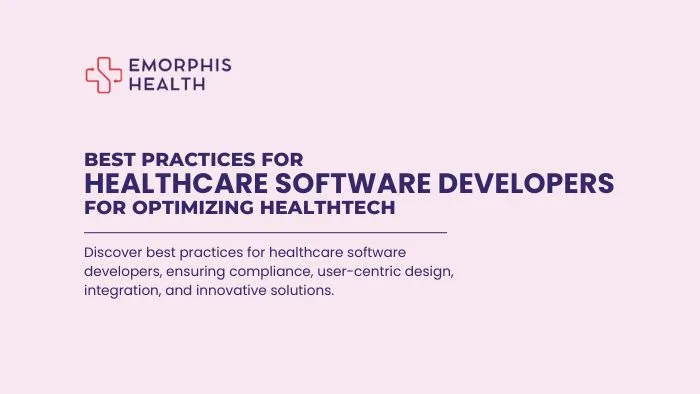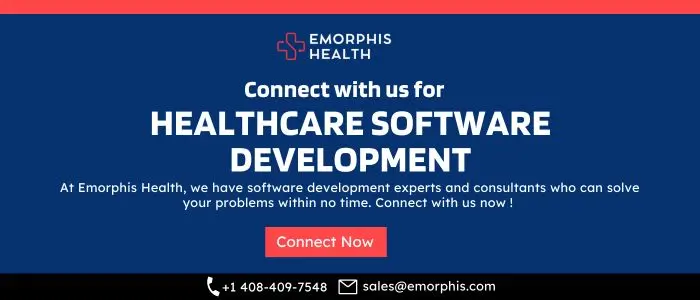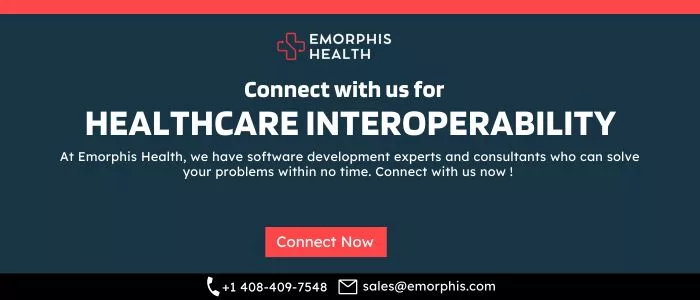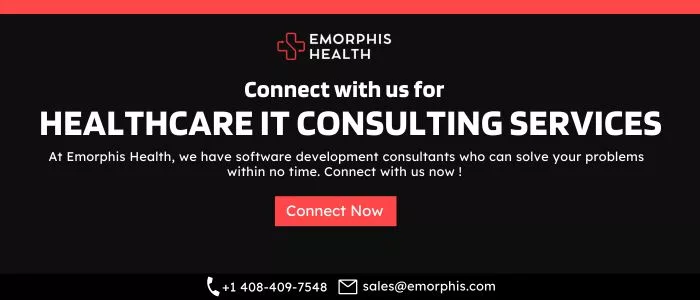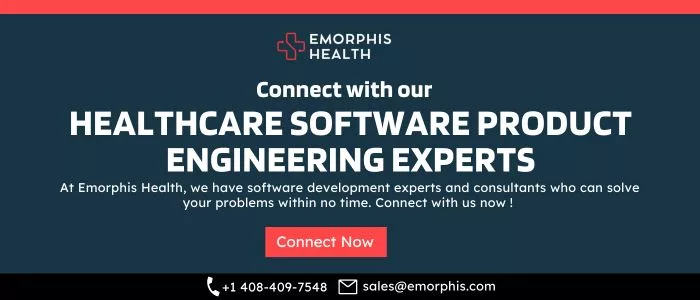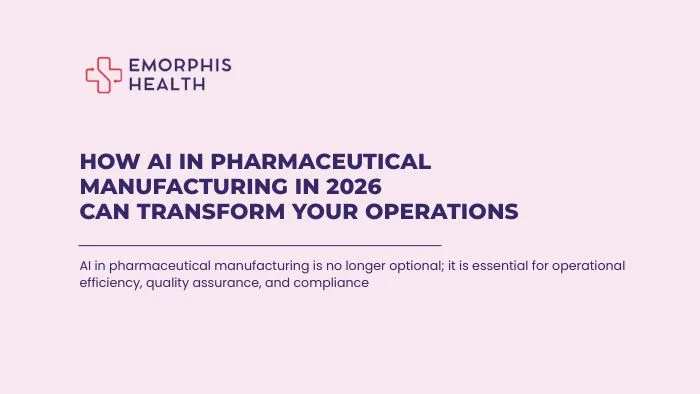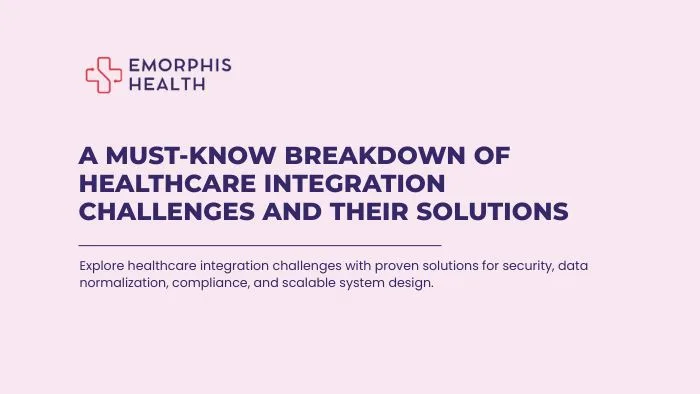Introduction
See Contents
- 1 Introduction
- 2 1. Regulatory Compliance and Security
- 3 2. User-Centered Design Principles
- 4 3. Interoperability and Integration
- 5 4. Agile Development Methodology
- 6 5. Test-Driven Development (TDD) in Healthcare
- 7 6. Collaborative Cross-Functional Teams
- 8 7. Continuous Monitoring and Maintenance
- 9 8. Accessibility and Inclusivity
- 10 Emerging Technologies in Healthcare Software
- 11 Conclusion
Creating healthcare software demands attention to detail. According to a report from Precedence Research, the global healthcare software as a service market was approximated to be USD 28.66 billion in 2022. Best practices play a pivotal role in ensuring the success of development projects for healthcare software developers. Additionally, regulatory compliance is of utmost importance to adhere to industry standards and safeguard patient data. This market is anticipated to achieve a valuation of approximately USD 77.43 billion by the year 2032. This growth reflects a robust compound annual growth rate (CAGR) of 10.5% from 2023 to 2032. The data highlights the increasing significance and opportunities for healthcare software developers in this expanding market.
Furthermore, a user-centered design enhances the user experience, addressing healthcare professionals’ and patients’ unique needs. Prioritizing intuitive interfaces improves software efficacy, streamlining workflows. Interoperability is vital for seamless integration into healthcare systems. Collaboration within cross-functional teams is key for understanding healthcare industry requirements. Continuous monitoring, bug-tackling, and timely updates are crucial. Accessibility features ensure inclusivity for diverse users. Integration of AI and machine learning brings innovation. Staying updated is essential for competitiveness in healthcare tech.
Overall, adopting these practices is fundamental for healthcare developers, enhancing software efficiency and improving healthcare services.
Now, let’s have a look at the best practices individually.
1. Regulatory Compliance and Security
Overview of Healthcare Regulations (e.g., HIPAA)
Healthcare software developers navigate a complex landscape of regulations, with a primary focus on standards like HIPAA. These regulations set the framework for safeguarding patient information and ensuring the ethical handling of healthcare data. Understanding the nuances of such regulations is imperative for developers to align their practices with legal and ethical requirements.
Ensuring Data Security and Patient Privacy
In the realm of healthcare software development, ensuring data security and upholding patient privacy are non-negotiable priorities. Developers must implement robust security measures, including encryption protocols and access controls, to safeguard sensitive information. This diligence not only protects patient privacy but also prevents unauthorized access, maintaining the integrity of healthcare data.
Best Practices for Handling Sensitive Healthcare Information
Handling sensitive healthcare information requires adherence to best practices. Healthcare software developers must adopt a proactive approach, incorporating encryption technologies, secure authentication methods, and regular audits. By staying abreast of evolving security standards and industry best practices, developers contribute to a secure and compliant healthcare software ecosystem. These practices not only protect patient data but also bolster the reputation and reliability of healthcare software solutions.
2. User-Centered Design Principles
Importance of User Experience in Healthcare Software
Healthcare software developers recognize the pivotal role of user experience in the success of their applications. User experience goes beyond aesthetics; it encompasses the ease of use, efficiency, and overall satisfaction of the end-users. By prioritizing a positive user experience, developers enhance the usability and adoption of healthcare software, contributing to improved workflows and user satisfaction.
Designing Intuitive Interfaces for Healthcare Professionals
In the realm of healthcare software development, creating intuitive interfaces is paramount, particularly for healthcare professionals. These interfaces should align with the workflow of medical practitioners, providing seamless navigation and efficient access to critical information. Healthcare software developers understand that intuitive design not only improves efficiency but also minimizes the learning curve for busy healthcare professionals, allowing them to focus on patient care.
Patient-Centric Design Approaches
Adopting patient-centric design approaches is a hallmark of effective healthcare software development. Patient-centric design goes beyond functionality; it considers the unique needs, preferences, and experiences of patients. By incorporating features that prioritize the patient’s perspective, healthcare software developers contribute to a more inclusive and patient-friendly healthcare ecosystem. This approach fosters better communication between healthcare providers and patients, ultimately improving the overall quality of care.
3. Interoperability and Integration
Challenges in Healthcare Data Interoperability
Healthcare software developers grapple with challenges in achieving seamless data interoperability. The diverse array of healthcare systems often presents hurdles in exchanging and interpreting information. Developers must address issues related to incompatible formats, varying standards, and disparate data sources. Understanding these challenges is essential for devising effective solutions that promote interoperability across the healthcare landscape.
Best Practices for Seamless Integration with Existing Healthcare Systems
To overcome challenges, healthcare software developers employ best practices for seamless integration with existing healthcare systems. This involves creating interfaces that can smoothly connect and communicate with different systems, ensuring the exchange of information without disruptions. By adopting standardized protocols and APIs, developers streamline the integration process, fostering a cohesive healthcare ecosystem that enhances communication and collaboration among disparate systems.
Standardization and Healthcare Information Exchange (HIE)
Standardization and Healthcare Information Exchange (HIE) play pivotal roles in achieving interoperability. Healthcare software developers prioritize the adoption of standardized data formats and protocols to facilitate seamless information exchange. Integration with HIE networks further enhances the accessibility and sharing of patient data among authorized entities. By adhering to these standardization practices, developers contribute to a more interconnected healthcare infrastructure, ultimately improving patient care through efficient and secure data exchange.
4. Agile Development Methodology
Adapting Agile Practices to Healthcare Software Development
Adopting an Agile development methodology is instrumental for healthcare software developers. Adapting Agile practices involves tailoring iterative and incremental development processes to the unique challenges of healthcare software projects. This flexibility allows developers to respond promptly to changing requirements and prioritize features that bring the most value to end-users.
Iterative Development and Continuous Improvement
In healthcare software development, iterative development is a fundamental aspect of the Agile methodology. Developers initiate the process by creating a minimum viable product, then gather feedback and iteratively enhance the software based on user input. This iterative approach not only speeds up time-to-market but also guarantees ongoing improvement. By embracing a cycle of feedback and refinement, healthcare software developers consistently deliver products that closely align with user needs and expectations.
Collaboration and Communication within Development Teams
Agile methodology places significant emphasis on collaboration and communication within development teams. In healthcare software development, cross-functional teams work closely to understand the unique requirements of the industry. Regular communication, stand-up meetings, and collaboration tools facilitate the exchange of ideas and insights. This collaborative approach ensures that the entire team remains aligned with project goals, promoting a cohesive and efficient development process.
5. Test-Driven Development (TDD) in Healthcare
Importance of Rigorous Testing in Healthcare Software
Rigorous testing is paramount in healthcare software development. The importance lies not only in ensuring the reliability and quality of the software but also in maintaining the integrity of patient data. Healthcare software developers recognize the critical role that thorough testing plays in delivering solutions that meet industry standards and user expectations.
Implementing TDD to Ensure Reliability and Quality
Test-Driven Development (TDD) stands out as an effective approach for ensuring the reliability and quality of healthcare software. Developers employing TDD write tests before the actual code, creating a systematic and comprehensive testing process. This method not only identifies potential issues early in the development cycle but also contributes to building a more robust and dependable healthcare software system.
Addressing Unique Testing Challenges in Healthcare Applications
Healthcare applications present unique testing challenges due to the sensitive nature of patient data and the criticality of accurate results. Healthcare software developers address these challenges by implementing specialized testing protocols. This includes thorough validation of data accuracy, compliance with regulatory requirements, and simulation of real-world scenarios to ensure the reliability and effectiveness of healthcare applications. By proactively addressing these challenges, developers contribute to the overall success and trustworthiness of healthcare software solutions.
6. Collaborative Cross-Functional Teams
Role of Cross-Functional Teams in Healthcare Software Development
Cross-functional teams play a pivotal role in healthcare software development. These teams bring together individuals with diverse skills, including developers, healthcare experts, and user experience designers. The collaboration within these teams ensures a holistic approach to software development, incorporating both technical expertise and domain-specific knowledge.
Facilitating Communication Between Developers and Healthcare Professionals
Effective communication is vital in healthcare software development, especially between developers and healthcare professionals. Cross-functional teams facilitate this communication by fostering an environment where developers can understand the unique needs and challenges faced by healthcare professionals. This collaboration ensures that the software aligns seamlessly with the workflows and requirements of healthcare practitioners.
Building Synergy for Successful Project Execution
Building synergy within cross-functional teams is essential for the successful execution of healthcare software projects. By leveraging the diverse skills and perspectives within the team, developers can address complex challenges more effectively. The synergy ensures that all aspects of the project, from technical implementation to user experience, are considered and integrated cohesively. This collaborative approach contributes to the overall success and impact of healthcare software development projects.
7. Continuous Monitoring and Maintenance
Proactive Monitoring of Healthcare Software Performance
Proactive monitoring is a critical aspect of maintaining the optimal performance of healthcare software. Continuous tracking of system metrics and user interactions allows developers to identify potential issues before they escalate. This proactive approach ensures a seamless user experience and minimizes the risk of disruptions in critical healthcare processes.
Addressing Bugs, Updates, and Security Patches
To uphold the integrity of healthcare software, addressing bugs, implementing updates, and applying security patches are ongoing responsibilities. Developers diligently identify and rectify software glitches, ensuring that the application remains reliable and secure. Timely updates and security patches are crucial for safeguarding patient data and adapting to evolving cybersecurity threats.
Strategies for Long-Term Software Maintenance
Long-term software maintenance requires strategic planning. Healthcare software developers implement strategies to manage the software’s evolution over time. This includes adopting modular architectures for scalability, documentation for ease of future updates, and regular evaluations of technological advancements. By employing effective long-term maintenance strategies, developers ensure the sustained performance and relevance of healthcare software throughout its lifecycle.
8. Accessibility and Inclusivity
Designing Healthcare Software for Accessibility
Designing healthcare software with accessibility in mind is imperative. Developers prioritize creating interfaces that accommodate individuals with diverse abilities. This includes features such as screen readers, adjustable font sizes, and color-contrast options. Such considerations ensure that healthcare software is accessible to users with varying needs and enhances the overall usability of the application.
Addressing the Needs of Diverse User Groups
Healthcare software developers actively address the needs of diverse user groups. This involves understanding the requirements of different user demographics, including patients, healthcare professionals, and administrators. By tailoring features and functionalities to cater to a broad spectrum of users, developers contribute to a more inclusive healthcare environment where technology meets the diverse needs of its users.
Ensuring Inclusive Practices in Software Development
Ensuring inclusive practices in software development goes beyond features—it’s about creating an inclusive mindset. Healthcare software developers foster a culture where diverse perspectives are valued. This approach includes considering cultural differences, language preferences, and varying levels of technology literacy. By embedding inclusivity into the development process, developers create healthcare software that accommodates the widest possible range of users, fostering equitable access and user satisfaction.
Above all, the best practices, the future demands continuous updating to stay ahead of evolving healthcare dynamics, technology advancements, and user expectations.
Hence, now let’s explore the emerging technologies.
Emerging Technologies in Healthcare Software
Integration of AI, Machine Learning, and IoT in Healthcare Solutions
The integration of emerging technologies such as Artificial Intelligence (AI), Machine Learning (ML), and the Internet of Things (IoT) is transforming healthcare software. These technologies enhance diagnostics, personalize patient care, and enable real-time monitoring. Healthcare software developers leverage these advancements to create solutions that contribute to improved clinical outcomes and patient experiences.
Staying Current with Technological Advancements
Healthcare software developers recognize the need to stay current with rapid technological advancements. Continuous learning and staying informed about the latest trends, updates, and breakthroughs in healthcare technology are essential. This proactive approach ensures that developers remain well-equipped to integrate cutting-edge technologies into healthcare software solutions, maintaining relevance in the dynamic healthcare IT landscape.
Balancing Innovation with Stability
Balancing innovation with stability is a key consideration for healthcare software developers. While embracing emerging technologies is crucial for staying competitive, maintaining the stability and reliability of healthcare systems is equally important. Striking a balance between innovation and stability ensures that healthcare software evolves with the industry’s technological landscape while providing a secure and dependable foundation for patient care and medical workflows.
Conclusion
In conclusion, healthcare software developers are instrumental in adhering to key best practices that contribute to the success and reliability of their solutions. From regulatory compliance to user-centered design, interoperability, and embracing emerging technologies, each practice plays a vital role in shaping the future of healthcare software.
This journey into best practices is not just a set of guidelines but a roadmap for success. Healthcare software developers are encouraged to wholeheartedly adopt these practices, recognizing their pivotal role in delivering high-quality, secure, and user-friendly software. By integrating these practices into their development processes, developers contribute to the advancement of healthcare technology and the improvement of patient outcomes.
The journey doesn’t end here. Continuous improvement is the heartbeat of successful healthcare software development. Developers are urged to remain vigilant, staying abreast of industry updates, regulatory changes, and technological advancements. By embracing a culture of continuous improvement, healthcare software developers can ensure that their solutions evolve to meet the ever-changing demands of the healthcare landscape, ultimately making a lasting impact on the quality of patient care.
Emorphis Health, a healthcare product engineering company, strictly adheres to best practices as healthcare software developers. They prioritize regulatory compliance, excel in user-centered design, ensure seamless data interoperability, and embrace Agile methodologies. Rigorous testing, inclusivity, and integration of emerging technologies underscore their commitment to delivering high-quality healthcare software solutions.

